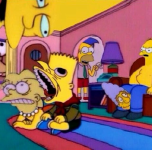Bipolar I Disorder is one of the most severe forms of mental illness and is characterized by recurrent episodes of mania and (more often) depression. The condition has a high rate of recurrence and if untreated, it has an approximately 15% risk of death by suicide. It is the third leading cause of death among people aged 15-24 years, and is the 6th leading cause of disability (lost years of healthy life) for people aged 15-44 years in the developed world.
Causation
Bipolar I Disorder is a life-long disease and runs in families but has a complex mode of inheritance. Family, twin and adoption studies suggest genetic factors. The concordance rate for monozygotic (identical) twins is 43%; whereas it is only 6% for dizygotic (nonidentical) twins. About half of all patients with Bipolar I Disorder have one parent who also has a mood disorder, usually Major Depressive Disorder. If one parent has Bipolar I Disorder, the child will have a 25% chance of developing a mood disorder (about half of these will have Bipolar I or II Disorder, while the other half will have Major Depressive Disorder). If both parents have Bipolar I Disorder, the child has a 50%-75% chance of developing a mood disorder. First-degree biological relatives of individuals with Bipolar I Disorder have elevated rates of Bipolar I Disorder (4%-24%), Bipolar II Disorder (1%-5%), and Major Depressive Disorder (4%-24%).
The finding that the concordance rate for monozygotic twins isn't 100% suggests that environmental or psychological factors likely play a role in causation. Certain environmental factors (e.g., antidepressant medication, antipsychotic medication, electroconvulsive therapy, stimulants) or certain illnesses (e.g., multiple sclerosis, brain tumor, hyperthyroidism) can trigger mania. Mania can be triggered by giving birth, sleep deprivation, and major stressful life events.
Symptoms
In adults, mania is usually episodic with an elevation of mood and increased energy and activity. In children, mania is commonly chronic rather than episodic, and usually presents in mixed states with irritability, anxiety and depression. In adults and children, during depression there is lowering of mood and decreased energy and activity. During a mixed episode both mania and depression can occur on the same day.
Comorbidity
Comorbidity is the rule, not the exception, in bipolar disorder. The most common mental disorders that co-occur with bipolar disorder are anxiety, substance use, and conduct disorders. Disorders of eating, sexual behavior, attention-deficit/hyperactivity, and impulse control, as well as autism spectrum disorders and Tourette's disorder, co-occur with bipolar disorder. The most common general medical comorbidities are migraine, thyroid illness, obesity, type II diabetes, and cardiovascular disease.
Associated Mental Disorders
Bipolar I Disorder is often associated with: alcoholism, drug addiction, Anorexia Nervosa, Bulimia Nervosa, Attention-Deficit Hyperactivity Disorder, Panic Disorder, and Social Phobia.
Diagnostic Tests
There are no diagnostic laboratory tests for Bipolar I Disorder. Thus diagnosis is arrived at by using standardized diagnostic criteria to rate the patient's behavior.

Differential Diagnosis
Bipolar I Disorder must be distinguished from:
Mood Disorder Due to a General Medical Condition (e.g., due to multiple sclerosis, stroke, hypothyroidism, or brain tumor)
Substance-Induced Mood Disorder (e.g., due to drug abuse, antidepressant medication, or electroconvulsive therapy)
Other Mood Disorders (e.g., Major Depressive Disorder; Dysthymia; Bipolar II Disorder; Cyclothymic Disorder)
Psychotic Disorders (e.g., Schizoaffective Disorder, Schizophrenia, or Delusional Disorder)
Since this disorder may be associated with hyperactivity, recklessness, impulsivity, and antisocial behavior; the diagnosis of Bipolar I Disorder must be carefully differentiated from Attention Deficit Hyperactivity Disorder, Conduct Disorder, Antisocial Personality Disorder, and Borderline Personality Disorder
Pathophysiology
The pathophysiology of Bipolar I Disorder is poorly understood. However, a variety of imaging studies suggests the involvement of structural abnormalities in the amygdala, basal ganglia and prefrontal cortex. Research is now showing that this disorder is associated with abnormal brain levels of serotonin, norepinephrine, and dopamine.
Prevalence
Bipolar I Disorder affects both sexes equally in all age groups and its worldwide prevalence is approximately 3-5%. It can even present in preschoolers. There are no significant differences among racial groups in the prevalence of this disorder.
Course
The first episode may occur at any age from childhood to old age. The average age at onset is 21. More than 90% of individuals who have a single Manic Episode go on to have future episodes. Untreated patients with Bipolar I Disorder typically have 8 to 10 episodes of mania and depression in their lifetime. Often 5 years or more may elapse between the first and second episode, but thereafter the episodes become more frequent and more severe.

There is significant symptom reduction between episodes, but 25% of patients continue to display mood instability or mild depression. As many as 60% of patients experience chronic interpersonal or occupational difficulties between acute episodes. Bipolar I Disorder may develop psychotic symptoms. The psychotic symptoms in Bipolar I Disorder only occur during severe manic, mixed or depressive episodes. In contrast, the psychotic symptoms in Schizophrenia can occur when there is no mania or depression. Poor recovery is more common after psychosis.
Manic episodes usually begin abruptly and last for between 2 weeks and 4-5 months (median duration about 4 months). Depressive episodes tend to last longer (median length about 6 months), though rarely for more than a year, except in the elderly.
Treatment And Outcome
The usual treatment for Bipolar I Disorder is lifelong therapy with a mood-stabilizer (either lithium, carbamazepine, or divalproex / valproic acid) often in combination with an antipsychotic medication. Usually treatment results in a dramatic decrease in suffering, and causes an 8-fold reduction in suicide risk. In mania, an antipsychotic medication and/or a benzodiazepine medication is often added to the mood-stabilizer. In depression, an antidepressant medication and/or lamotrigine is often added to the mood-stabilizer. Since antidepressant medication can trigger mania, this medication should always be combined with a mood-stablizer or antipsychotic medication to prevent mania.
Research has shown that the most effective treatment is a combination of supportive psychotherapy, psychoeducation, and the use of a mood-stabilizer (often combined with an antipsychotic medication). There is no research showing that any form of psychotherapy is an effective substitute for medication. Likewise there is no research showing that any "health food store nutritional supplement" (e.g., vitamin, amino acid) is effective for Bipolar I Disorder.
Since a Manic Episode can quickly escalate and destroy a patient's career or reputation, a therapist must be prepared to hospitalize out-of-control manic patients before they "lose everything". Likewise, severely depressed, suicidal bipolar patients often require hospitalization to save their lives.
Although the medication therapy for Bipolar I Disorder usually must be lifelong, the majority of bipolar patients are noncompliant and stop their medication after one year. At 4-year follow-up of bipolar patients, 41% have a good overall outcome and 4% have died. Women with bipolar disorder lose, on average, 9 years in life expectancy, 14 years of lost productivity and 12 years of normal health
Best Recoveries
The best recoveries are achieved when individuals with Bipolar I Disorder:
Get the correct diagnosis (since many are misdiagnosed as having schizophrenia or "just borderline personality")
Get effective treatment and faithfully stay on it for a lifetime (50% need only a mood-stabilizer, but the other 50% require the combination of a mood-stabilizer and an antipsychotic medication)
Adopt a healthy lifestyle (regular sleep and exercise; no alcohol or drug abuse; low stress)
Regularly see a supportive physician who is knowledgeable about the psychiatric management of this disorder
Learn which symptoms predict the return of this illness, and what additional "rescue" medication should be taken
Learn to trust the warnings given by family and friends when they see early signs of relapse
Learn as much as possible about this illness from therapists, the Internet, books, or self-help groups





















































































































Causation
Bipolar I Disorder is a life-long disease and runs in families but has a complex mode of inheritance. Family, twin and adoption studies suggest genetic factors. The concordance rate for monozygotic (identical) twins is 43%; whereas it is only 6% for dizygotic (nonidentical) twins. About half of all patients with Bipolar I Disorder have one parent who also has a mood disorder, usually Major Depressive Disorder. If one parent has Bipolar I Disorder, the child will have a 25% chance of developing a mood disorder (about half of these will have Bipolar I or II Disorder, while the other half will have Major Depressive Disorder). If both parents have Bipolar I Disorder, the child has a 50%-75% chance of developing a mood disorder. First-degree biological relatives of individuals with Bipolar I Disorder have elevated rates of Bipolar I Disorder (4%-24%), Bipolar II Disorder (1%-5%), and Major Depressive Disorder (4%-24%).
The finding that the concordance rate for monozygotic twins isn't 100% suggests that environmental or psychological factors likely play a role in causation. Certain environmental factors (e.g., antidepressant medication, antipsychotic medication, electroconvulsive therapy, stimulants) or certain illnesses (e.g., multiple sclerosis, brain tumor, hyperthyroidism) can trigger mania. Mania can be triggered by giving birth, sleep deprivation, and major stressful life events.
Symptoms
In adults, mania is usually episodic with an elevation of mood and increased energy and activity. In children, mania is commonly chronic rather than episodic, and usually presents in mixed states with irritability, anxiety and depression. In adults and children, during depression there is lowering of mood and decreased energy and activity. During a mixed episode both mania and depression can occur on the same day.
Comorbidity
Comorbidity is the rule, not the exception, in bipolar disorder. The most common mental disorders that co-occur with bipolar disorder are anxiety, substance use, and conduct disorders. Disorders of eating, sexual behavior, attention-deficit/hyperactivity, and impulse control, as well as autism spectrum disorders and Tourette's disorder, co-occur with bipolar disorder. The most common general medical comorbidities are migraine, thyroid illness, obesity, type II diabetes, and cardiovascular disease.
Associated Mental Disorders
Bipolar I Disorder is often associated with: alcoholism, drug addiction, Anorexia Nervosa, Bulimia Nervosa, Attention-Deficit Hyperactivity Disorder, Panic Disorder, and Social Phobia.
Diagnostic Tests
There are no diagnostic laboratory tests for Bipolar I Disorder. Thus diagnosis is arrived at by using standardized diagnostic criteria to rate the patient's behavior.

Differential Diagnosis
Bipolar I Disorder must be distinguished from:
Mood Disorder Due to a General Medical Condition (e.g., due to multiple sclerosis, stroke, hypothyroidism, or brain tumor)
Substance-Induced Mood Disorder (e.g., due to drug abuse, antidepressant medication, or electroconvulsive therapy)
Other Mood Disorders (e.g., Major Depressive Disorder; Dysthymia; Bipolar II Disorder; Cyclothymic Disorder)
Psychotic Disorders (e.g., Schizoaffective Disorder, Schizophrenia, or Delusional Disorder)
Since this disorder may be associated with hyperactivity, recklessness, impulsivity, and antisocial behavior; the diagnosis of Bipolar I Disorder must be carefully differentiated from Attention Deficit Hyperactivity Disorder, Conduct Disorder, Antisocial Personality Disorder, and Borderline Personality Disorder
Pathophysiology
The pathophysiology of Bipolar I Disorder is poorly understood. However, a variety of imaging studies suggests the involvement of structural abnormalities in the amygdala, basal ganglia and prefrontal cortex. Research is now showing that this disorder is associated with abnormal brain levels of serotonin, norepinephrine, and dopamine.
Prevalence
Bipolar I Disorder affects both sexes equally in all age groups and its worldwide prevalence is approximately 3-5%. It can even present in preschoolers. There are no significant differences among racial groups in the prevalence of this disorder.
Course
The first episode may occur at any age from childhood to old age. The average age at onset is 21. More than 90% of individuals who have a single Manic Episode go on to have future episodes. Untreated patients with Bipolar I Disorder typically have 8 to 10 episodes of mania and depression in their lifetime. Often 5 years or more may elapse between the first and second episode, but thereafter the episodes become more frequent and more severe.

There is significant symptom reduction between episodes, but 25% of patients continue to display mood instability or mild depression. As many as 60% of patients experience chronic interpersonal or occupational difficulties between acute episodes. Bipolar I Disorder may develop psychotic symptoms. The psychotic symptoms in Bipolar I Disorder only occur during severe manic, mixed or depressive episodes. In contrast, the psychotic symptoms in Schizophrenia can occur when there is no mania or depression. Poor recovery is more common after psychosis.
Manic episodes usually begin abruptly and last for between 2 weeks and 4-5 months (median duration about 4 months). Depressive episodes tend to last longer (median length about 6 months), though rarely for more than a year, except in the elderly.
Treatment And Outcome
The usual treatment for Bipolar I Disorder is lifelong therapy with a mood-stabilizer (either lithium, carbamazepine, or divalproex / valproic acid) often in combination with an antipsychotic medication. Usually treatment results in a dramatic decrease in suffering, and causes an 8-fold reduction in suicide risk. In mania, an antipsychotic medication and/or a benzodiazepine medication is often added to the mood-stabilizer. In depression, an antidepressant medication and/or lamotrigine is often added to the mood-stabilizer. Since antidepressant medication can trigger mania, this medication should always be combined with a mood-stablizer or antipsychotic medication to prevent mania.
Research has shown that the most effective treatment is a combination of supportive psychotherapy, psychoeducation, and the use of a mood-stabilizer (often combined with an antipsychotic medication). There is no research showing that any form of psychotherapy is an effective substitute for medication. Likewise there is no research showing that any "health food store nutritional supplement" (e.g., vitamin, amino acid) is effective for Bipolar I Disorder.
Since a Manic Episode can quickly escalate and destroy a patient's career or reputation, a therapist must be prepared to hospitalize out-of-control manic patients before they "lose everything". Likewise, severely depressed, suicidal bipolar patients often require hospitalization to save their lives.
Although the medication therapy for Bipolar I Disorder usually must be lifelong, the majority of bipolar patients are noncompliant and stop their medication after one year. At 4-year follow-up of bipolar patients, 41% have a good overall outcome and 4% have died. Women with bipolar disorder lose, on average, 9 years in life expectancy, 14 years of lost productivity and 12 years of normal health
Best Recoveries
The best recoveries are achieved when individuals with Bipolar I Disorder:
Get the correct diagnosis (since many are misdiagnosed as having schizophrenia or "just borderline personality")
Get effective treatment and faithfully stay on it for a lifetime (50% need only a mood-stabilizer, but the other 50% require the combination of a mood-stabilizer and an antipsychotic medication)
Adopt a healthy lifestyle (regular sleep and exercise; no alcohol or drug abuse; low stress)
Regularly see a supportive physician who is knowledgeable about the psychiatric management of this disorder
Learn which symptoms predict the return of this illness, and what additional "rescue" medication should be taken
Learn to trust the warnings given by family and friends when they see early signs of relapse
Learn as much as possible about this illness from therapists, the Internet, books, or self-help groups






















































































































